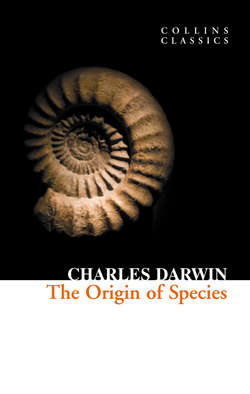Читать книгу The Origin of Species - Charles Darwin, Charles Darwin - Страница 18
Many of The Species Included Within The Larger Genera Resemble Varieties in Being Very Closely, but Unequally, Related to Each other, and in having Restricted Ranges.
ОглавлениеThere are other relations between the species of large genera and their recorded varieties which deserve notice. We have seen that there is no infallible criterion by which to distinguish species and well-marked varieties; and when intermediate links have not been found between doubtful forms, naturalists are compelled to come to a determination by the amount of difference between them, judging by analogy whether or not the amount suffices to raise one or both to the rank of species. Hence the amount of difference is one very important criterion in settling whether two forms should be ranked as species or varieties. Now Fries has remarked in regard to plants, and Westwood in regard to insects, that in large genera the amount of difference between the species is often exceedingly small. I have endeavoured to test this numerically by averages, and, as far as my imperfect results go, they confirm the view. I have also consulted some sagacious and experienced observers, and, after deliberation, they concur in this view. In this respect, therefore, the species of the larger genera resemble varieties, more than do the species of the smaller genera. Or the case may be put in another way, and it may be said, that in the larger genera, in which a number of varieties or incipient species greater than the average are now manufacturing, many of the species already manufactured still to a certain extent resemble varieties, for they differ from each other by a less than the usual amount of difference.
Moreover, the species of the larger genera are related to each other, in the same manner as the varieties of any one species are related to each other. No naturalist pretends that all the species of a genus are equally distinct from each other; they may generally be divided into sub-genera, or sections, or lesser groups. As Fries has well remarked, little groups of species are generally clustered like satellites around other species. And what are varieties but groups of forms, unequally related to each other, and clustered round certain forms—that is, round their parent-species. Undoubtedly there is one most important point of difference between varieties and species, namely, that the amount of difference between varieties, when compared with each other or with their parent-species, is much less than that between the species of the same genus. But when we come to discuss the principle, as I call it, of divergence of character, we shall see how this may be explained, and how the lesser differences between varieties tend to increase into the greater differences between species.
There is one other point which is worth notice. Varieties generally have much restricted ranges. This statement is indeed scarcely more than a truism, for if a variety were found to have a wider range than that of its supposed parent-species, their denominations would be reversed. But there is reason to believe that the species which are very closely allied to other species, and in so far resemble varieties, often have much restricted ranges. For instance, Mr. H.C. Watson has marked for me in the well-sifted London catalogue of Plants (4th edition) sixty-three plants which are therein ranked as species, but which he considers as so closely allied to other species as to be of doubtful value: these sixty-three reputed species range on an average over 6.9 of the provinces into which Mr. Watson has divided Great Britain. Now, in this same catalogue, fifty-three acknowledged varieties are recorded, and these range over 7.7 provinces; whereas, the species to which these varieties belong range over 14.3 provinces. So that the acknowledged varieties have very nearly the same restricted average range, as have the closely allied forms, marked for me by Mr. Watson as doubtful species, but which are almost universally ranked by British botanists as good and true species.
